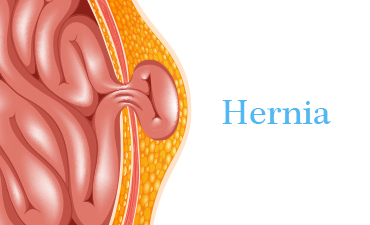A hernia occurs when an organ or fatty tissue squeezes through a weak spot in a surrounding muscle or connective tissue called fascia. If any sign of this shows up, it is highly recommended to get a hernia surgery.
There are 5 types of hernia. The most common types of hernia are inguinal, sportsmans, femoral, incisional, and umbilical.
Inguinal Hernia
Inguinal hernias are located in the lower abdomen just above the leg crease, near or adjacent to the pubic area. They can sometimes show up on both sides of the pubic area, and if they do, they are called bilateral inguinal hernias. Inguinal hernias, along with femoral hernias make up the 2 types of groin hernias and can produce pain that extends into the upper thigh or scrotum. Inguinal hernias can be classified as “direct” or “indirect”.
At least 4 of every 10 patients looking for hernia surgery at Varanasi Hospital suffers from this type of hernia.
Sportsman’s Hernia
This is a condition of chronic exercise-related supra-inguinal groin pain. Generally, it involves a direct inguinal hernia. Symptoms are the pain in the groin without any detectable swelling in the groin or any other explanation for the pain. Before choosing surgery for a sportsman’s hernia, all non-operative possibilities should be attempted, including sufficient relief and rehabilitation of the most tender structures and muscles.
Femoral Hernia
This along with inguinal hernias are groin hernias. They are much more common in women but can occur in men too. These hernias appear just below the groin crease. A weakness in the lower groin allows an intestinal sac to drop into the femoral canal, a space near the femoral vein that carries blood from the leg. These hernias are more prone than inguinal hernias to develop incarceration or strangulation as an early sign. Therefore, once these hernias are diagnosed, timely hernia surgery is very strongly advised before such complications occur.
Incisional Hernia
This one appears in the abdomen at the site of a previous surgery is known as an incisional hernia. These hernias can appear weeks, months, or even years after surgery and can vary in size from small to very large and complex. If you think you have an incisional hernia, it is important to see your doctor because it may widen and become extremely difficult to repair.
Umbilical Hernia
Happens near the belly button or navel, which has a natural weakness from the blood vessels of the umbilical cord. These hernias may occur in infants at or just after birth and may resolve by three or four years of age. However, the area of weakness can persist throughout life and can occur in men, women, and children at any time. In adults, umbilical hernias will not resolve on its own and may progressively worsen over time, making hernia surgery inevitable.
These are the most common types of hernias addressed by the experts at Varanasi Hospital. It is always recommended to get a hernia surgery if any of this occurs.



Comments are closed here.